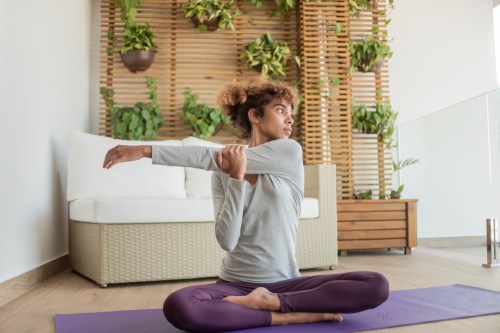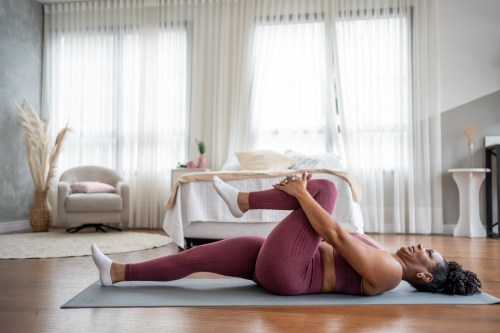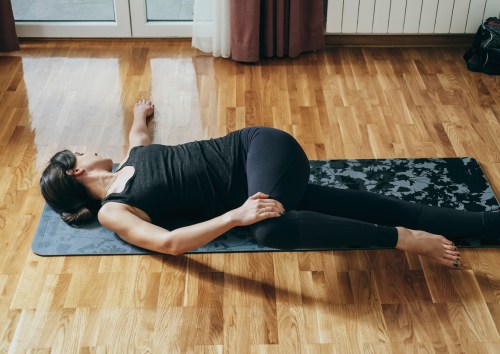Take a seat and get into a comfortable position. Close your eyes and focus on your breathing for 10 seconds. Now take a deep breath. Hold that breath for four seconds. Breathe out for four seconds. Look at that, we’re meditating! Now, if you’re anything like me, that was a difficult 18 seconds.
Experts in This Article
yoga and meditation instructor for Peloton
Meditation has always been a struggle for me. I’ve been a HIIT instructor for seven years, so slowing down just isn’t something I think about very often. But lately I’ve found myself more interested in meditation and its numerous benefits, wondering how I can add the practice into my lifestyle in a way that I’ll actually enjoy.
In my search to learn more about meditation, I spoke to Peloton instructor Kirra Michel. Though she now teaches meditation and yoga, there was a time when she didn’t actually enjoy it. Who better to get tips from than a person who has shared my same feelings about meditation?
Michel has a background in dancing and rhythmic gymnastics, so movement comes naturally to her and has always served as a way to process her emotions. So when it came to meditation, she says, “I couldn’t fathom how sitting would help me in any capacity when I’ve been taught to move through my mental and emotional strains and issues.”
“Rather than just being dragged around by my mind and my emotions, meditation allowed me to stop and realize that not every thought I think is real, and to sit with my emotions.” —Kirra Michel, Peloton instructor
Michel got into meditation when she started getting curious about her mind and wanted the tools to better understand it.
“I’m a very emotional woman,” she says. “So rather than just being dragged around by my mind and my emotions, meditation allowed me to stop and realize that not every thought I think is real, and to sit with my emotions.”
One of the challenges I’ve always had with meditation is I can’t stop thinking. I start by focusing on my breathing, as the guide tells me to, and the next thing I know I’m making my grocery list or wondering how high a grasshopper can jump.
I always thought the purpose of meditation was to completely clear the mind, but Michel explains you’re not a bad meditator if you’re thinking—in fact, your mind will never go completely blank to the point where you have no thoughts. Your mind is designed to think, plot, and problem solve, according to Michel.
“One of my favorite exercises to do when I’m teaching someone to meditate is to get them to write down everything they think— every single thing that comes to their mind for two minutes. The brain goes everywhere,” she says.
One of the challenges I’ve always had with meditation is I can’t stop thinking. I start by focusing on my breathing, as the guide tells me to, and the next thing I know I’m making my grocery list or wondering how high a grasshopper can jump.
The benefits of meditation that’ll convince you to give it a try (again)
The benefits of meditation, according to Michel, are:
- General self awareness
- Ownership of emotions
- Downregulating your nervous system to a calmer state
- Lower levels of cortisol (the stress hormone)
- Better organization
“These benefits don’t happen overnight,” Michel says. “I think about it like going to the gym. You know it’s good for you and you’re not going to get the goals that you’re trying to achieve today, but if you continuously come back time and time again, you’ll start to see some of these benefits.”
Want to start a meditation practice you don’t hate? Follow these pro tips
If you’re looking to start your own meditation practice but are finding it difficult to get started, Michel shares some of her favorite tips.
Although meditation might be uncomfortable now, remember the benefits are worth it when you show up at the mat every day, meeting yourself with kindness and compassion, Michel says.
1. Start small
Michel suggests approaching meditation in manageable increments. You don’t have to meditate for long periods of time for it to be beneficial.
“It could be a five-minute sit to get started. That may be great for a prolonged period of time, and eventually you start to elongate the sit,” Michel says.
2. Try habit stacking
Another way to make meditation a part of your routine is to connect it to a habit you already have, like brushing your teeth. This is what’s known as habit stacking.
You know you’ll brush your teeth every morning, so when you’re done, that can be your cue to meditate. Michel says she meditates right when she wakes up.
“I don’t check my phone and I meditate. If I mess that up in any capacity I usually miss my meditation,” she says.
3. Find your vibe
There are all kinds of meditation, including, but not limited to, metta (a love and kindness meditation), transcendental meditation (a mantra-based meditation), visualization meditation (visualizing things in your mind), and mindfulness meditation (focusing on your breath). Not every form of meditation is for everybody, so it’s important to find one that works for you.
It’s also crucial to find practitioner you like.
“I hated yoga until I found the right teacher. When I found someone who I could relate to, I was excited about it,” Michel says. “My teacher had to look like a punk in order for me to feel like, ‘Oh I can relate to you. You’re blunt, you swear—okay, let’s do it!’”
Sign Up for Our Daily Newsletter
Get all the latest in wellness, trends, food, fitness, beauty, and more delivered right to your inbox.
Got it, you've been added to our email list.











